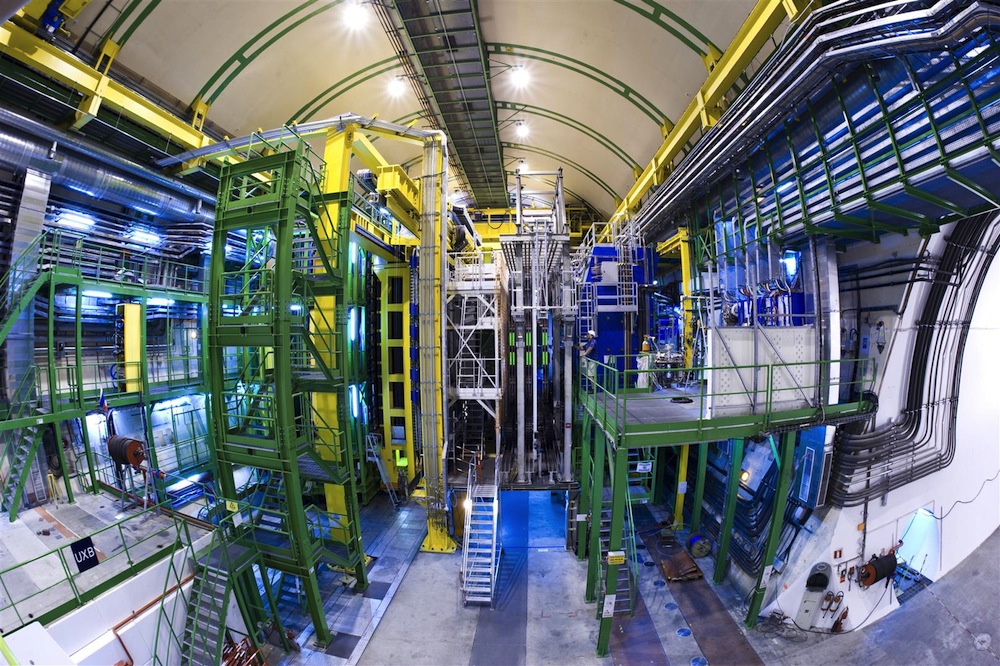World's Largest Atom Smasher May Have Just Found Evidence for Why Our Universe Exists

For the first time ever, physicists at the world’s largest atom smasher have observed differences in the decay of particles and antiparticles containing a basic building block of matter, called the charm quark.
The finding could help explain the mystery of why matter exists at all.
"It's a historic milestone," said Sheldon Stone, a professor of physics at Syracuse University and one of the collaborators on the new research.
Matter and antimatter
Every particle of matter has an antiparticle, which is identical in mass but with an opposite electrical charge. When matter and antimatter meet, they annihilate one another. That's a problem. The Big Bang should have created an equivalent amount of matter and antimatter, and all of those particles should have destroyed each other rapidly, leaving nothing behind but pure energy. [Strange Quarks and Muons, Oh My! Nature’s Tiniest Particles Dissected]
Clearly, that didn't happen. Instead, about 1 in a billion quarks (the elementary particles that make up protons and neutrons) survived. Thus, the universe exists. What that means is that particles and antiparticles must not behave entirely identically, Stone told Live Science. They should instead decay at slightly different rates, allowing for an imbalance between matter and antimatter. Physicists call that difference in behavior the charge-parity (CP) violation.
The notion of the CP violation came from Russian physicist Andrei Sakharov, who proposed it in 1967 as an explanation for why matter survived the Big Bang.
"This is one of the criteria necessary for us to exist," Stone said, "so it's kind of important to understand what the origin of CP violation is."
Get the Space.com Newsletter
Breaking space news, the latest updates on rocket launches, skywatching events and more!
There are six different types of quarks, all with their own properties: up and down, top and bottom and charm and strange. In 1964, physicists first observed the CP violation in real life in strange quarks. In 2001, they saw it happen with particles containing bottom quarks. (Both discoveries led to Nobel prizes for the researchers involved.) Physicists had long theorized that it happened with particles containing charm quarks, too, but no one had ever seen it.
Charmed, I'm sure
Stone is one of the researchers on the Large Hadron Collider (LHC) beauty experiment, which uses CERN's Large Hadron Collider, the 16.5-mile (27 kilometer) ring on the French-Swiss border that sends subatomic particles careening into one another to re-create the flashes of mind-boggling energy that followed the Big Bang. As the particles smash into each other, they break into their constituent parts, which then decay within fractions of a second to more stable particles.
The latest observations involved combinations of quarks called mesons, specifically the D0 ("d-zero") meson and the anti-D0 meson. The D0 meson is made up of one charm quark and one anti-up quark (the antiparticle of the up quark). The anti-D0 meson is a combination of one anti-charm quark and one up quark.
Both of these mesons decay in many ways, but some small percentage of them end up as mesons called kaons or pions. The researchers measured the difference in decay rates between the D0 and the anti-D0 mesons, a process that involved taking indirect measurements to ensure they weren't just measuring a difference in the initial production of the two mesons, or differences in how well their equipment could detect various subatomic particles.
The bottom line? The ratios of decay differed by a tenth of a percent.
"The means the D0 and the anti-D0 don't decay at the same rate, and that's what we call CP violation," Stone said.
And that makes things interesting. The differences in the decays probably isn't big enough to explain what happened after the Big Bang to leave behind so much matter, Stone said, though it is large enough to be surprising. But now, he said, physics theorists get their turn with the data. [Big Bang to Civilization: 10 Amazing Origin Events]
Physicists rely on something called the Standard Model to explain, well, everything at the subatomic scale. The question now, Stone said, is whether the predictions made by the Standard Model can explain the charm quark measurement the team just made, or if it will require some sort of new physics — which, Stone said, would be the most exciting outcome.
"If this could only be explained by new physics, that new physics could contain the idea of where this CP violation is coming from," he said.
Researchers announced the discovery in a CERN webcast and published a preprint of a paper detailing the results online.
- What's That? Your Physics Questions Answered
- The 18 Biggest Unsolved Mysteries in Physics
- Photos: The World's Largest Atom Smasher (LHC)
Originally published on Live Science.
Join our Space Forums to keep talking space on the latest missions, night sky and more! And if you have a news tip, correction or comment, let us know at: community@space.com.

Stephanie Pappas is a contributing writer for Space.com sister site Live Science, covering topics ranging from geoscience to archaeology to the human brain and behavior. She was previously a senior writer for Live Science but is now a freelancer based in Denver, Colorado, and regularly contributes to Scientific American and The Monitor, the monthly magazine of the American Psychological Association. Stephanie received a bachelor's degree in psychology from the University of South Carolina and a graduate certificate in science communication from the University of California, Santa Cruz.










